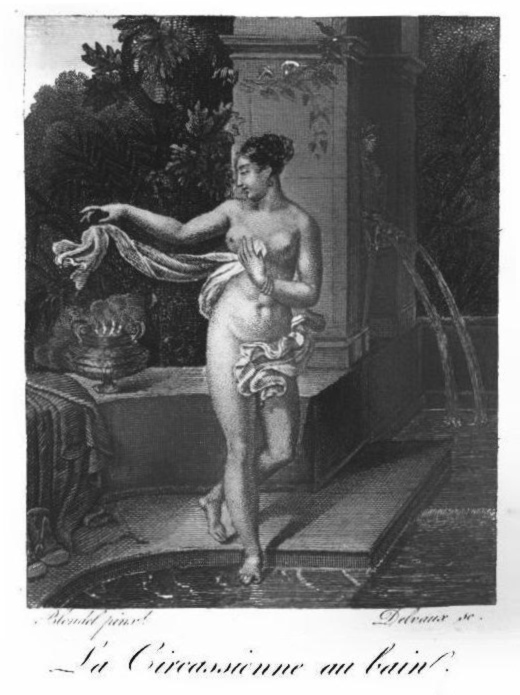La Circassienne Au Bain on:
[Wikipedia]
[Google]
[Amazon]
 ''La Circassienne au Bain'' ("The Circassian Bath"), also known as ''Une Baigneuse'' ("The Bath"), was a large Neoclassical
''La Circassienne au Bain'' ("The Circassian Bath"), also known as ''Une Baigneuse'' ("The Bath"), was a large Neoclassical
 ''La Circassienne au Bain'' ("The Circassian Bath"), also known as ''Une Baigneuse'' ("The Bath"), was a large Neoclassical
''La Circassienne au Bain'' ("The Circassian Bath"), also known as ''Une Baigneuse'' ("The Bath"), was a large Neoclassical oil painting
Oil painting is a painting method involving the procedure of painting with pigments combined with a drying oil as the Binder (material), binder. It has been the most common technique for artistic painting on canvas, wood panel, or oil on coppe ...
from 1814 by Merry-Joseph Blondel depicting a life-sized young naked Circassian woman bathing in an idealized setting from classical antiquity
Classical antiquity, also known as the classical era, classical period, classical age, or simply antiquity, is the period of cultural History of Europe, European history between the 8th century BC and the 5th century AD comprising the inter ...
. The painting was lost with the sinking of the ''Titanic'' in 1912. When financial compensation claims were filed with US commissioner Gilchrist in January 1913, the painting gained notoriety as the subject of the largest claim made against the White Star Line for the loss of a single item of baggage or cargo.
History
Louvre exhibition
The painting was first exhibited at the Paris Salon, at theLouvre
The Louvre ( ), or the Louvre Museum ( ), is a national art museum in Paris, France, and one of the most famous museums in the world. It is located on the Rive Droite, Right Bank of the Seine in the city's 1st arrondissement of Paris, 1st arron ...
museum in November 1814. The initial critical reaction to the painting was muted, with positive descriptions restricted to praising the painting's overall competence and Merry-Joseph Blondel's attention to detail. Apart from technical misgivings about the twist of the upper body and the absence of 'grace' in the figure of the young woman, the chief concern of the critics seems to have been that, despite its large scale, it was not as exciting a painting as some of Blondel’s previous works. However, by 1823, critics began talking more enthusiastically about the painting, apparently influenced both by the favourable popular reception to printed reproductions of the painting and by Blondel’s improving career status.
Loss on the RMS ''Titanic''
In January 1913, a claim was filed in New York against the White Star Line, by '' Titanic'' survivor Mauritz Håkan Björnström-Steffansson, for financial compensation resulting from the loss of the painting. The amount of the claim was $100,000 (equivalent to $ million in ), making it by far the most highly valued single item of luggage or cargo lost as a result of the sinking. Bjornstrom-Steffansson did not receive the compensation he asked; all the cases against White Star were settled for a combined amount of $644,000.Size of the painting
Steffansson's claim form described a substantial painting "8 x 4 feet" in size, but did not specify whether this referred to the painted canvas size, the canvas plus frame or the crate size.''District Court of the United States, Southern district of New York, Claim by H. Bjornstrom-Steffanson - Exhibit A'', 9 January 1913, US National Archives, New York. This format does not conform to the standard size conventions for full-length portraits, formalised during the 19th century. Neither does it match the format ratio of any known full-length portrait by Blondel. Extant full length, life-sized standing female portraits by Blondel, in the public domain, conform to the French standard ''F120'' (''figure 120'') sized canvas (), within a margin of plus or minus .References
External links
* {{DEFAULTSORT:Circassienne au Bain 1814 paintings Neoclassical paintings RMS Titanic Lost paintings Nude paintings of women Bathing in art Artworks exhibited at the Salon of 1814